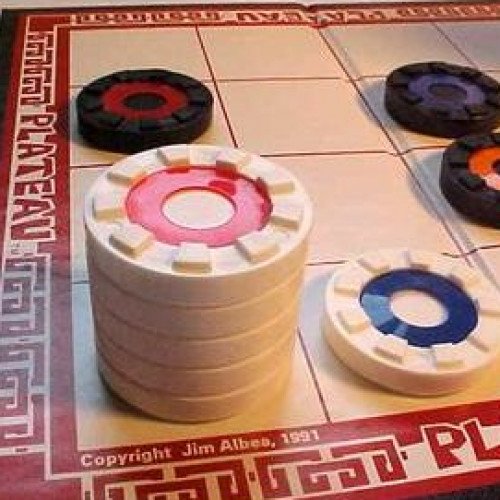COMMANDS & COLORS: ANCIENTS VS PLATEAU

COMMANDS & COLORS: ANCIENTS
Commands & Colors: Ancients is a board wargame designed by Richard Borg, Pat Kurivial, and Roy Grider, and published by GMT Games in 2006. It is based on Borg's Commands & Colors system using some elements similar to his other games such as Commands & Colours: Napoleonics, The Great War, Memoir '44 and Battle Cry designed to simulate the "fog of war" and uncertainty encountered on real battlefields. Commands & Colors: Ancients focuses on the historic period of 3000 BC - 400 AD. The core game includes several hundred wood blocks in two colors for the Roman/Syracusan armies and Carthaginian army. Sheets of stickers representing different unit types must be affixed to the blocks prior to initial play. 16 small wooden blocks representing "victory banners" and 7 larger plastic dice must also have stickers applied. Extra stickers are included for use as replacements. The game also contains a full-color rule book, color scenario book, and two color two-page double-sided "cheat sheets" for players to reference during play for dice results and unit statistics. The board is folded card stock laid flat for play. Hexagonal terrain pieces are laid on the board when called for by a scenario. A deck of command cards is included. Units are arranged on the board according to maps and scenario descriptions in the scenario book. Players are dealt a number of command cards equal to their "command value" for the chosen scenario. Often players have different command values and therefore different numbers of cards. Players take turns playing their cards to "order" units, generally allowing the ordered units to move and conduct combat. Cards often refer to a section of the battlefield, either left, center, or right, or some combination of these. There are also many special cards that allow very specific actions. Play continues until one player earns the requisite number of victory banners for the scenario. Victory banners are earned each time a player completely eliminates an enemy unit or leader.
Statistics for this Xoptio

PLATEAU
Plateau is a two-player abstract strategy board game invented by Jim Albea. The game was developed over a two-year period culminating in its present form on May 12, 1986. The original name for the game was Pinnacle, but it was discovered that an older board/card game had that name, so around 1989 the name was changed to Plateau. From the 1980s through the 1990s Plateau was played at Science Fiction conventions mostly in the Southeastern United States. From the 1990s to the present, the game is played live at an online game site and via email. In 1997 a computer implementation of the game was created which facilitates email play and has a computer robot. Onboarding is adding one new piece to the play. This new piece can be placed anywhere that doesn't directly harm an opposing piece. For instance, you can onboard to any blank square or on top of any of your own pieces. The majority of Plateau moves are onboards. Instead of Onboarding or Moving, a player can choose to spend his turn exchanging prisoners. Prisoners are exchanged using the point values of the pieces. A simple value-for-value system is used. Since the pieces range in value from 1 point (for the mute) to 21 points (for the Ace) there are usually several combinations and options available for the players. The player initiating the exchange selects the pieces he wishes to exchange. These pieces will all add up to some point value. The responding player then has four options depending on the point values of the prisoners that he holds.